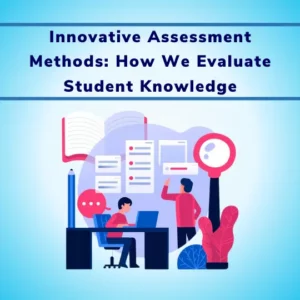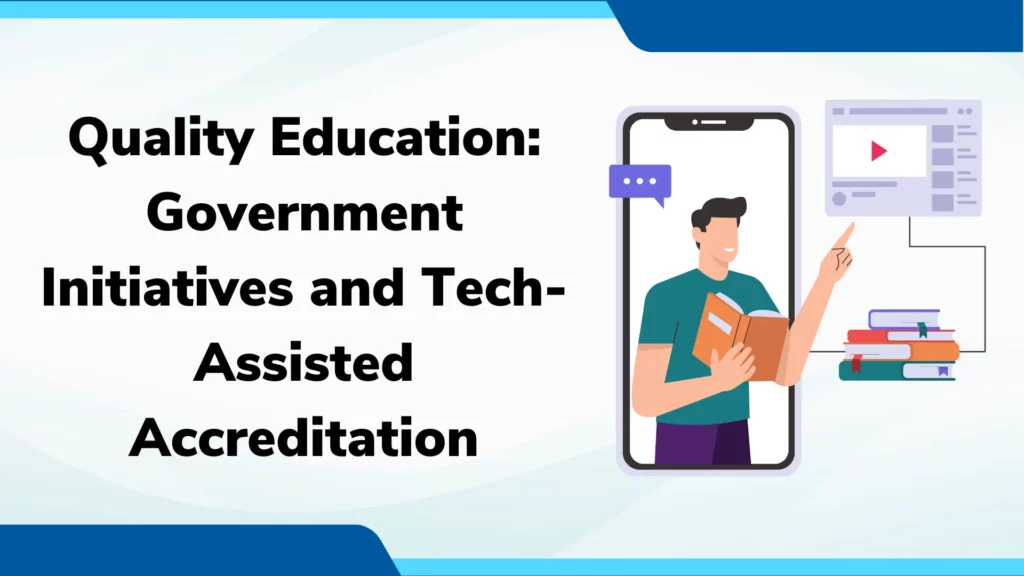
Article Contents
Introduction
Quality education is the cornerstone of a nation’s progress, and government initiatives play a major role in India. In India, accreditation processes like the National Board of Accreditation (NBA), and the National Assessment and Accreditation Council (NAAC) have been in place to evaluate and maintain the standards of educational institutions. By shifting the focus towards the practical application of knowledge and skills, student progress can be achieved.
The Indian government has initiated various schemes, portals, online platforms, and frameworks to achieve outcome-based success among students. By connecting with the power of technology, institutions can collect and analyze data on student performance, engagement, and learning outcomes, enabling them to tailor educational approaches to individual needs.
The collaborative approach of the government and technology-assisted accreditation can lead to more effective educational systems. However, it’s time to rethink and restore these initiatives to focus more on student outcomes and learning results!
The Role of Government
Why is the government involved in education? The answer is simple! It’s the government’s responsibility to ensure that all students receive a high-quality education. The role of the government in ensuring quality education is multifaceted and crucial.
The Government of India recognized that education is the foundation for socio-economic development and that it is essential to empower the future workforce with the knowledge and skills needed to thrive in an ever-changing world. As such, they have a responsibility to create an enabling environment that promotes access to quality education for all citizens.
Accreditation is one of the primary tools used by the government to achieve this goal. Through accreditation processes, the government sets clear benchmarks and guidelines that educational institutions must meet to maintain a certain standard of quality.
These standards encompass various aspects of an institution’s functioning, including curriculum design, faculty qualifications, infrastructure, research output, student support services, and more.
Beyond setting standards, the government also plays a role in funding and supporting educational institutions. It allocates resources to improve infrastructure, provide training for teachers and administrators, and enhance research capabilities. Financial aid and scholarship programs are introduced to ensure that students from all socio-economic backgrounds can access quality education.
Understanding Accreditation and Its Evolution
Accreditation is a critical process that evaluates and certifies the quality and credibility of educational institutions. It assures students, parents, employers, and other stakeholders that the institution meets certain established standards and is committed to delivering quality education.
In India, several organizations are responsible for overseeing accreditation, including the National Board of Accreditation (NBA), and the National Assessment and Accreditation Council (NAAC).
Over the years, the accreditation process has evolved in response to various factors, including advancements in pedagogy, technology, and changes in the job market. Initially, accreditation primarily focused on inputs, such as physical facilities and faculty qualifications, to ensure a basic level of infrastructure and faculty competence. However, there has been a significant shift towards outcomes-based accreditation, which emphasizes the actual results and achievements of students.
- The accreditation process has evolved to incorporate changing educational landscapes and international best practices.
- Initially focused on inputs, accreditation now emphasizes outcomes, assessing student achievements and success.
- Global orientation of accreditation promotes alignment with international standards and encourages collaboration between institutions.
- Technology plays a key role, enabling more efficient data collection and analysis for evidence-based decision-making.
- Accreditation fosters a culture of continuous improvement, enhancing institutions’ reputation and attracting students and faculty.
Government Initiatives to Improve Accreditation
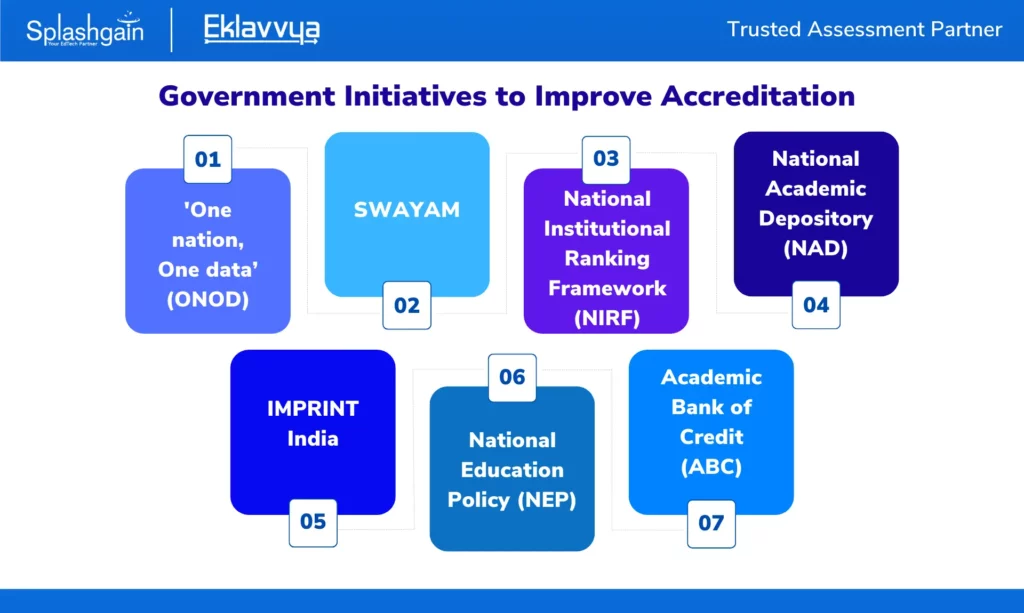
To make accreditation more effective, the government is introducing exciting new changes! Instead of just focusing on inputs, the new approach will prioritize student outcomes and learning results! Hurray for this student-centric shift!
‘One nation, One data’ (ONOD)
The government is creating a new portal called ‘One Nation, One Data’ for higher education institutions in the country. This portal will be a single place where all the data related to colleges, universities, and other higher education institutes will be collected and shared.
The purpose of this portal is to improve the assessment and accreditation system of these institutions. Currently, different regulatory bodies collect data from various institutions, which can be confusing and inefficient. With this new portal, all the data will be collected in one place, making it easier to manage and analyze.
The work on the portal has already started, and the main task is to gather and organize all the data from different institutions. This data will be cross-checked with the respective colleges and universities to ensure accuracy and avoid any mistakes or duplications. Once the portal is ready, it will streamline the data-sharing process, making it more effective for all parties involved.
SWAYAM
SWAYAM (Study Webs of Active-Learning for Young Aspiring Minds) is an integrated online platform launched. SWAYAM is an online platform developed by the Ministry of Education. It offers free courses in different subjects taught by top-notch teachers from important institutions in the country. This platform aims to make education accessible to everyone, and students can study at their speed and convenience.
SWAYAM allows learners to take online tests and earn academic credits, which recognize their knowledge and abilities. It has made a significant impact on distance education, leading to better outcomes for students and expanding educational opportunities for all.
National Institutional Ranking Framework (NIRF)
The National Institutional Ranking Framework (NIRF) was established by the Ministry of Education, Government of India. The framework aimed to rank higher education institutions across the country based on various parameters, with a strong emphasis on student outcomes.
The parameters included teaching, learning, and resources; research and professional practices; graduation outcomes; outreach and inclusivity; and perception. By ranking institutions publicly, this initiative promotes competition and encourages them to keep getting better.
It creates a culture of continuous improvement, where colleges and universities strive to provide high-quality education.
IMPRINT India
IMPRINT India (Impacting Research Innovation and Technology) was launched as a collaborative effort between the Ministry of Human Resource Development (now the Ministry of Education) and various Indian Institutes of Technology (IITs). This initiative aimed to identify and support research projects that address the most critical challenges faced by the nation.
Through a rigorous evaluation process, projects with high potential for societal impact and tangible student outcomes were prioritized for funding. IMPRINT India facilitated innovative research opportunities for students and encouraged institutions to focus on real-world problem-solving.
National Academic Depository (NAD)
The National Academic Depository is a digital platform that securely stores academic records such as degrees, diplomas, certificates, and mark sheets. By creating a centralized and easily accessible repository, students can access their academic documents whenever required, ensuring transparency and authenticity.
The NAD simplifies verification processes and minimizes document forgery, thus bolstering the credibility of the Indian education system.
National Education Policy (NEP)
The landmark National Education Policy 2020 is a good initiative that seeks to transform the Indian education system widely. With a strong emphasis on student-centricity, the NEP focuses on transforming the accreditation process by shifting the focus from inputs to outcomes.
It promotes holistic development, critical thinking, and creativity, aiming to make students future-ready and skill-equipped. The policy also advocates the integration of technology and the promotion of research and innovation.
Academic Bank of Credit (ABC)
An Academic Bank of Credit is a system that allows students to accumulate academic credits earned from various educational institutions and use them towards completing a degree or diploma program. The credits earned in this system are typically transferable between institutions, offering students greater flexibility in their educational journey.
The implementation of an Academic Bank of Credit would require collaboration and standardization among educational institutions, government bodies, and accrediting agencies.
Benefits of Improving the Accreditation Process
Improved accreditation means better education! Through this process, educational institutions become more accountable and transparent! Additionally, it enhances the overall educational outcomes and contributes to students’ success! That’s good for the future!
Improving the accreditation process brings many benefits to education. Firstly, it makes sure that educational institutions follow higher standards, leading to better quality education. By setting clear goals, institutions focus on getting better and improving their teaching, faculty qualifications, and support services.
This makes them more responsible and transparent, building trust among stakeholders. Students and parents can make informed choices about their education. The focus on student outcomes means institutions care about students’ success and create a supportive learning environment.
As a result, students do better academically and have more opportunities. Overall, improving accreditation ensures a brighter future for education, where institutions strive for excellence, and students have the best chances to succeed and achieve their goals.
Challenges in Implementing New Accreditation Policies
Every path has hurdles, and so do these initiatives! Some institutions might resist changes, while others may face resource constraints. However, with determination and collaboration, we can overcome these obstacles!
Challenges in implementing new accreditation policies:
- Resistance from some educational institutions.
- Resource constraints in certain institutions.
- Limited funding for meeting new standards.
- Lack of technological infrastructure in some institutions.
- Need for awareness and communication about the benefits of the new process.
- Collaborative efforts and peer learning are required.
- Support and guidance for institutions facing challenges.
- Importance of collective commitment to improving education quality.
The Future of Accreditation
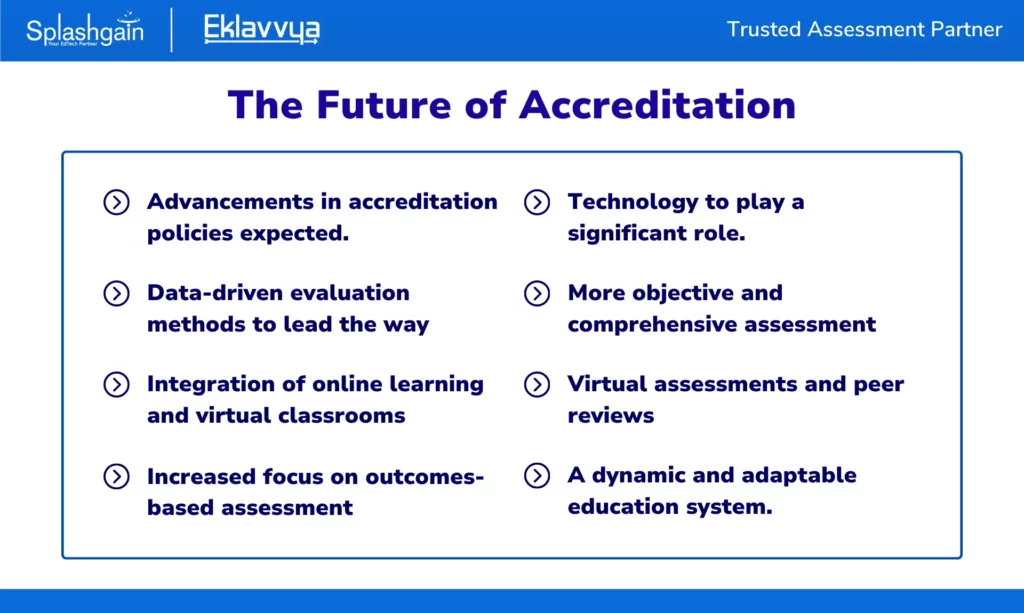
What does the future hold? Exciting changes await! We expect further developments in accreditation policies! Technology will play a significant role, with data-driven evaluation methods leading the way! How fascinating!
The future of accreditation holds promising possibilities with exciting changes on the horizon. We can anticipate further advancements in accreditation policies to improve the education system. Technology will be a key driver, transforming the way institutions are evaluated. Data-driven evaluation methods will take centre stage, using data and analytics to assess the performance of educational institutions.
- Advancements in accreditation policies are expected.
- Technology plays a significant role.
- Data-driven evaluation methods to lead the way.
- More objective and comprehensive assessment.
- Integration of online learning and virtual classrooms.
- Virtual assessments and peer reviews.
- Increased focus on outcomes-based assessment.
- A dynamic and adaptable education system.
New Era of Technology
Technology plays a crucial role in supporting the government’s initiatives for improving accreditation and enhancing the overall quality of education in India. Accreditation software is a powerful tool that can significantly streamline and enhance the accreditation process, making it more efficient, transparent, and data-driven.
- Accreditation software streamlines the process, making it easier and more efficient.
- It collects and analyzes data quickly and fairly, ensuring accurate assessments.
- The technology tracks students’ progress and success after graduation for better evaluation.
- Automation reduces manual work, saving time and effort for institutions.
- Real-time feedback promotes continuous improvement and identifies areas for enhancement.
- Collaboration is improved, fostering better communication among accrediting bodies, institutions, and stakeholders.
- Information is readily accessible, increasing transparency and informed decision-making.
- Accreditation software stays up-to-date with changing standards, ensuring relevance.
- Data security is a top priority, keeping sensitive information safe and protected.
Conclusion
In India, we need to work together to create a better future for education. This means that government bodies, educational institutions, teachers, students, and other stakeholders must collaborate to develop a student-centred accreditation system.
The new approach of the Indian government is to focus on continuous improvement, adaptability, and innovative teaching methods to meet the changing needs of students and the job market.
It’s time to take important steps towards transforming the education system in India through improved government initiatives for accreditation. By focusing on student outcomes and learning results, we can raise the standard of education, increase institutional liability, and secure a better future for the nation.
To achieve this, the Indian government has taken the lead in implementing these necessary changes and nurturing a favourable environment for educational excellence. By investing in quality education the government can drive significant progress in the educational landscape of the country.
Technology plays a key role. Automation and real-time data processing will lead to accurate assessments. This approach will support the government’s quality education goals.
By focusing on student outcomes, we can improve educational institutions’ accountability and transparency! Let’s join hands and work towards a brighter future for education in India! Together, we can make a difference!
Accreditation is a process that evaluates and certifies the quality and credibility of educational institutions.
Accreditation ensures that institutions meet certain standards and provide high-quality education.
Technology streamlines the process, collects data efficiently, and enhances collaboration.



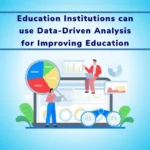
![How Government-Led Exams at 250+ Locations Are Setting New Standards of Integrity [Case Study]](https://www.eklavvya.com/blog/wp-content/uploads/2024/04/Enhancing-Exam-Integrity-Government-Certification-in-250-Locations-150x150.webp)
![Transforming Central Govt. Exams Evaluation: How Onscreen Marking is Leading the Charge [Case Study]](https://www.eklavvya.com/blog/wp-content/uploads/2024/04/How-Onscreen-Marking-Revolutionized-Central-Govt-Exams-Case-Study-1-150x150.webp)
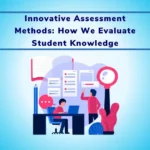












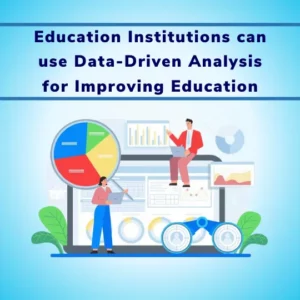

![How Onscreen Marking Revolutionized Central Govt Exams [Case Study]](https://www.eklavvya.com/blog/wp-content/uploads/2024/04/How-Onscreen-Marking-Revolutionized-Central-Govt-Exams-Case-Study-1-300x300.webp)
